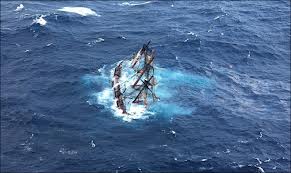Our latest Notable Narrative is “Sunk,” a detailed narrative of the deadly capsizing of the tall ship HMS Bounty during Hurricane Sandy. Kathryn Miles’ story, in Outside magazine, gave a gripping account of the historic vessel’s final hours and what might have led the crew to sail directly into the storm. Miles, an author and Unity College professor in Maine, talked to us about the piece by email this week:
Storyboard: The headline of your piece is “Sunk: The Incredible Truth about a Ship that Never Should Have Sailed.” It clearly lays out the angle of your piece. What, to you, was the most convincing piece of reporting that led you to believe the ship never should have left port?
Miles: In reporting this story, I spent a lot of time interviewing Coast Guard commanders and rescuers, along with meteorologists and ship captains. There was strong consensus among these experts that the Bounty should not have left the docks in New London. I suppose you could say the headline pays homage to their knowledge and judgment.
You have experience writing about tall ships. Can you tell us a bit about how you came to that and why the subject interests you?
I was raised by parents who sail, so I’ve always had an interest in ships. It wasn’t until I began researching my new book, All Standing: the Remarkable Story of the Jeanie Johnston, the Legendary Irish Famine Ship, that I really fell head-over-heels for square-rigged ships like the Bounty and Jeanie Johnston. They’re easy to love: For centuries, they carried everything from cargo to explorers to immigrants. Today, they have a certain cultural currency that is romantic for many. Having worked as crew for several of these vessels, I understand that infatuation in some really visceral ways.
Was there major competition over the Bounty story or were you the only one trying to land the big narrative?
There was a fair amount of competition. I first approached Elizabeth Hightower Allen, the features editor at Outside, the day the ship went down. She told me that they had quite a few pitches streaming in, but she’d add mine to the pile. We worked together to refine the pitch for the rest of the editorial staff: Some of the issues she really wanted me to emphasize included whether or not I might have special access to crew, and my degree of expertise about tall ship sailing in general. It was a very collaborative process from the start.
 The turnaround time was pretty fast. The ship sank in October and you published in, what, this month’s issue of Outside? Which means you’d have closed the issue in late December? Early January?
The turnaround time was pretty fast. The ship sank in October and you published in, what, this month’s issue of Outside? Which means you’d have closed the issue in late December? Early January?
The story will actually appear in the April print issue. We chose to break the story early online, because we knew that much of my reporting would become known once the hearings began. The composition process itself was tricky, because the trajectory of the final story was constantly evolving. Initially, we anticipated that we would be publishing what we knew was a very dramatic sinking and subsequent rescue. But as I dug deeper, I began to uncover allegations of neglect and patterns of suspect behavior, which required careful attention. Just before the story was due, I learned of the DeRamus foundation and its role, so I made an unexpected New Year’s trip to California, where I interviewed them as well. I wrote my first draft on the plane coming home, and filed in early January. When Elizabeth saw the complexity of the story at hand, she encouraged me to go back and write it much bigger. At one point, the story was over 13,000 words long. It’s her expertise that got it back down to size.
How did you approach the reporting?
This was a very difficult story to report for several reasons. Immediately after the sinking, everyone was fighting for access – particularly to the Coast guard rescuers and the Bounty crew, who were on a collective media lockdown. And throughout the process, the ongoing Coast Guard/NTSB investigation made many people reluctant to speak out, particularly on record. The Bounty crew felt – and continues to feel – persecuted by the media and the general public, and many are still experiencing significant effects from post-traumatic stress disorder. That required a delicate and empathetic hand. To gain access, I used a lot of my contacts in the sailing world, which tends to be a fairly tight community, and I also made heavy use of discussion boards and e-groups online. The rest was just old-fashioned reporting: a lot of phone calls, a lot of walking around shipyards asking questions.
What’s your method for handling large amounts of information?
My doctorate is in English literature. I used to joke that it’s a pretty unused degree, but I found that training hugely useful for this particular story. In a lot of ways, this was about building a collective narrative, so I was always looking for those moments where stories converged and deviated. I’m a pretty tactile person, so I kept hard copies of a lot of my research, and at night I’d spread it out on my kitchen table, looking for patterns and synthesis as well as the gaps that needed filling.
Could you characterize the structure of the piece and tell us how you chose to build it that way?
Sure. The story follows what people in creative nonfiction might call a segmented essay or what my undergraduate journalism professor always called the “boxcar” structure: In this case, the story was seven distinct scenes or moments. I knew I had to begin by building tension and, of course, acknowledging what all of my readers already knew, which was that the Bounty sank and two crew members died. Because the vessel’s final hours and the harrowing rescue of the surviving crew was the most dramatic and narrative-driven part of the story, I used that chronology as my focus and then looked for those moments where I could step away and provide background or other supporting information.
What were the biggest challenges with this piece – regarding either the reporting or the writing – and how did you handle them?
With regard to the reporting, the biggest challenge was absolutely getting people to talk. As for the story, I kept bumping my head against the word limit. Outside was incredibly generous in the amount of space it gave me, but this story kept wanting to get bigger and bigger.
What revelation surprised you the most and why?
Some of the most chilling revelations were very definitely the allegations former crew members made against the Bounty’s owners regarding the ship’s condition. I think the most surprising – and heartwarming – was meeting Ashley DeRamus, the 30-year-old woman with Down syndrome. Hearing about her connection to the ship, and to those who died, was a very powerful experience.
Have you been attending the hearings? What have the hearings shown?
I’ve been following them by simulcast, and I admit I’m completely obsessed. As I told a Coast Guard spokesperson this morning, they’re better than any TV crime drama. Some of the most significant testimony has been about the condition of the vessel and the captain’s decision to set sail. We’ve heard multiple accounts of rot in the ship’s hull and malfunctioning equipment. Interestingly, we’ve also learned a lot about the failures of some of the standard-issue rescue equipment and protocols. I suspect this will lead to new Coast Guard regulations and perhaps even industrywide redesigns of key items like life rafts. We’re going to be hearing about the Bounty for a long time to come.
Did you know immediately that you wanted to do the piece for Outside, or did you also have other publications in mind?
 As soon as I heard the ship went down, I knew this story had to appear in Outside. It’s a narrative that has obvious appeal to the magazine’s readers. But more importantly, Outside is a magazine known for its attention to narrative. Books including The Perfect Storm and Into Thin Air got their start there, and I knew this story was going to have a similar trajectory.
As soon as I heard the ship went down, I knew this story had to appear in Outside. It’s a narrative that has obvious appeal to the magazine’s readers. But more importantly, Outside is a magazine known for its attention to narrative. Books including The Perfect Storm and Into Thin Air got their start there, and I knew this story was going to have a similar trajectory.
Can you say a bit about your writing career – how you came to journalism and the kind of work you now do?
I started working as a cub reporter for a daily newspaper while I was in high school. It was a compromise the school’s principal and I made to minimize my resistance to being a full-time (and well-behaved) student there. In college, I really fell in love with literature and theory, which prompted me to pursue the PhD in English, but I tried to keep current by writing a few feature stories a year. I see a surprising amount of overlap between these two fields, and I’m particularly taken by the narrative nonfiction that defines the school of New Journalism, as well as writers like John McPhee and Susan Orlean. In my current role as the director of the Environmental Writing program at Unity College, I encourage my students to consider the way different genres can inform one another. We’re a species defined by our love of narrative. No matter what medium we adopt, writers have to tell good stories.
What’s the best piece of narrative advice anyone ever gave you?
My agent, Wendy Strothman, is always urging me to “find the story.” What she means is the importance of utilizing literary techniques like narrative arc, character development and conflict. She’s right, of course, and I think my writing is at its strongest when I’m able to internalize this idea.
What’s the best narrative advice you could give other journalists?
Read deeply and promiscuously.
What are you working on now?
We’re expanding the article into a book. I’m excited: There’s so much more to tell.



